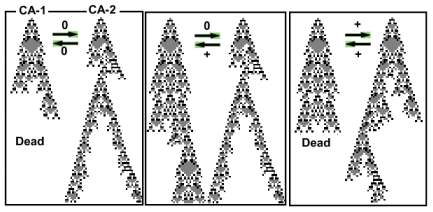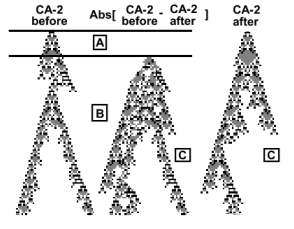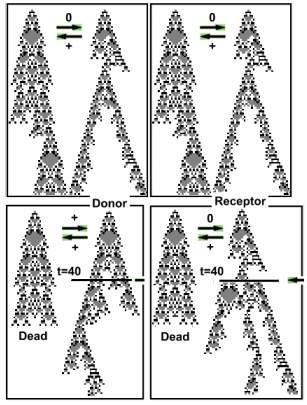 |
Parasitism
Host and parasite
The experiment starts with planting two zygotes (left frame).
The CA are isolated, do not interact and their impact is, I = {0. 0}. CA-1 , the parasite is short lived,
while CA-2, the host lives undisturbed. In the next frame CA-1 encroaches
upon CA-2 draws from it resources, which contribute to its prolonged survival.
I = {0, +}. Soon CA-2 develops immunity against the parasite. Now
both interact and their mutual impact is, I = {+, +}.
 |
Impact
The impact of one CA on the other, is proportional to its structure. When CA widens, its impact intensifies, and vice versa. Despite the
fact that the encroaching CA-1 draws resources from CA-2, the impact is
of CA-2 on CA-1. Impact indicates the direction in which information and
resources flow. In the third frame host draws resources from parasite, which
change its structure and contribute to its immunity. Immunity is
defined as a mutual interaction, or impact, which kills the parasite and
leaves the host alive.
Structural change of CA-2 is correlated with its immunity. In order to appreciate how the host changed during immunity, its structure was subtracted from that of an isolated host which is not immune. The figure in the center of the image below is portrays the absolute difference between the CA-2 before and after interaction with CA-1. During the first days after zygote planting, CA-2 does not interact with CA-1 and their structures do not change. The difference in area A is zero (white). The greatest change occurred in area B. The tail in area C indicates that it existed in the isolated host and and does not exist in the immunized CA-2.
 |
Immunity transfer
Host immunity is inbuilt in the structure marked by B. We may now ask which CA-2 state contributed to the host immunity? The next experiment starts with two zygote couples. The first interact in the same way as described above. At t = 40, the immune CA-2 donates its structure to the non immune CA-2 of the second couple. Some time later CA-1 died which indicates that the transferred structure conferred immunity on the receptor CA-2. Following transfer, CA-2 receptor structure evolves in a different way than that of the donor CA-2, since their respective impacts differ. While impact of the donor is I = {+,+}, impact of the receptor CA-2 remains I = { 0 , +}.
 |
The structure which was transferred from donor to receptor
contains information how to resist CA-1. It is distributed in the
entire state observed at t = 40. It is an information about action,
and ought to be distinguished from information in form of signals.
Setup
switchstate [3, 2, j, 40, 1]; effect[1, 30 + 2 sa[[2]]]; effect[2,
15 + sa[[1]]]; effect[3, 15 ];